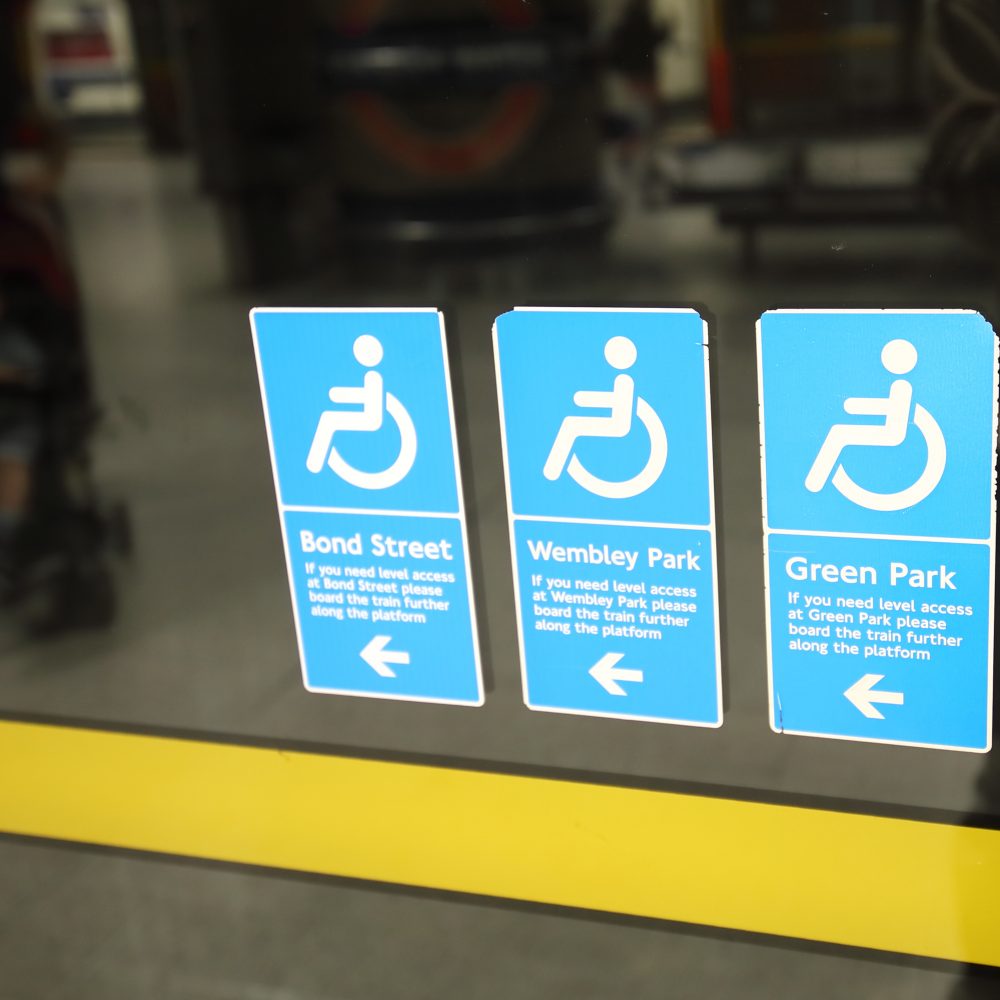Context and policy overview
In 2018, the Greater London Authority (GLA) identified the need to invest in a more inclusive transport system to ensure equal access for all of its citizens. The system faced numerous challenges. First, the findings of a 2015 survey conducted by Transport for London (TfL) showed that disabled and older people experienced greater barriers than other groups when it came to moving around the city.[1] The barriers are not limited to physical impediments, such as uneven pavements or inconvenient routes, but included noise levels, pollution, street clutter and the fear of crime.[2] Second, affordable transport posed a significant challenge for people living in poverty, as well as young people, people living with disabilities and those who were economically inactive.[3] In 2015, the share of Londoners living in poverty was 27 per cent ‒ 7 per cent above the national average ‒ underscoring the need to make the transport system more affordable for more people.[4] Lastly, crime and the fear of crime, which disproportionally affect women, people with disabilities, older people and those from ethnic minority groups, was deterring people from taking full advantage of access to transit.[5] London’s Inclusive Transit Strategy (ITS) sought to address these challenges.
Before 2018, some steps had already been taken to facilitate access to the transit system and make the infrastructure more inclusive, addressing some of the financial, physical and economic barriers. The Mayor of London and TfL froze fares and introduced unlimited one-hour bus and tram “Hopper” transfers at no extra cost for all passengers using contactless or pay-as-you-go ticketing. Older people benefited from a Freedom Pass, which gave them free travel across London, while people with a long-term or permanent disability could request a bookable door-to-door mini-bus service through the Dial-a-Ride service.[6] From 2016, Underground train (Tube) services operated 24 hours a day, 7 days a week.
Still, a more robust and harmonised strategy to comprehensively tackle the issue of inclusivity was needed. The national government, through the Department of Transport, took action in 2018, launching the national ITS. The ITS is a flagship initiative aimed at ensuring equal access to the transit system for everyone across the country.[7] In London, it is being coordinated by Mayor Sadiq Khan and TfL and aims to address the physical, financial and safety barriers preventing Londoners from fully availing of the urban transit system.[8]
Implementation
To implement the ITS, the Mayor and TfL focused on addressing challenges related to affordability, inclusion and safety. They created a roadmap to achieve these goals, which expanded on the measures taken in prior years.
To make travel more affordable, the Mayor and TfL planned to extend the city’s suburban rail services to encompass a larger radius for people living further from central London and to harmonise fares across the different modes of transport run by TfL.
Their approach focused on both physical and intangible barriers, with £76 million from the Healthy London Partnership fund allocated to the project over five years. An additional £17 million was allocated with a view to increasing the number of accessible bus stops to 95 per cent ‒ an increase of 30 per cent.[9] The projected improvements in the physical elements of the transport system included more tactile paving, soft-touch handrails, fully accessible ticket machines and an increase in the share of step-free Tube access from 25 per cent to 40 per cent by 2022 by adding appropriate infrastructure, including escalators and ramps.[10]
Among the intangible improvements, the strategy entailed making a broader range of information (such as the number of steps per station) readily available to transit users via a proprietary smartphone app. This would be supplemented with paper maps and a team of customer service representatives to provide personalised and timely information to people less likely or unable to access the internet.
Lastly, to tackle safety issues, the project dedicated £3.4 million over five years to hiring and training British Transport Police officers to offer “support and visible reassurance” to nighttime travellers.[11] The strategy also foresaw the introduction of more services per hour on important bus lines to cut waiting times and, in turn, ease the fear and discomfort to users caused by long waiting times.
A year after the strategy was introduced, London’s Transport Committee launched an investigation to assess the results and any outstanding gaps.[12] The Committee held two meetings: the first involving an expert panel from TfL, Network Rail and Transport for All and the second comprising representatives from community-based organisations and other local stakeholders. The findings were published in a report entitled From Step-Free to Stress-Free and have become an important tool for ensuring that policies put in place achieve their stated goals.[13]
Barriers and obstacles to success
One of the key impediments to successfully implementing the ITS in London was the existence of some inclusivity-oriented policies that did not perform well and were not updated promptly to comply with the new standards. The results of the Committee’s investigation, published in 2019, showed, for example, that the Dial-a-Ride service was consistently poorly rated by users due to inconsistency and unreliability.[14]
Another barrier to success was TfL’s failure to consider inclusion in all of its initiatives. For example, users described the process of getting a Freedom Pass ‒ the travel pass instituted in 1973 for residents over the age of 60 or with disabilities ‒ as burdensome and a potential obstacle for older or disabled people, who might not have the necessary assistance to obtain it. Indeed, the application can only be completed online or by mail and there are no TfL support staff to facilitate the process. This can pose a challenge for the elderly or people with certain disabilities. Thus, the impact of this policy to reduce financial barriers to transit may have been lessened by the administrative barriers involved.
Despite initiatives such as the Freedom Pass, affordability remained a barrier to the success of the ITS, however, specifically for low-income people, unskilled workers and young people. A report found that Londoners spent on average 7 per cent of their take-home pay – rising to 10 per cent for young and/or unskilled people – on travel, making London’s transit system more expensive than other cities.[15]
Though the strategy had some success, it is important to note that some of the inclusion-oriented policies introduced prior to the ITS had brought about positive results in terms of increasing the accessibility of the transit system. Therefore, the strategy built on a pre-existing foundation and knowledge base.
Also, as the ITS had initially been launched at the national level, London benefitted from various levels of government support in implementing its initiative. With the city benefiting from funding and expertise at different levels of government, the envisioned successes were not necessarily down to the Mayor and City Hall alone.
Results and lessons learned
Since the launch of the strategy, several changes have been made to the London transit system’s physical infrastructure. TfL reports that 95 per cent of bus stops are now accessible to wheelchair users, while both the Docklands Light Rail (DLR) and tram network are step-free.[16] What’s more, 79 Tube stations ‒ 29 per cent of all stations in London ‒ have been rendered step-free. While the strategy is ongoing, some of the important milestones accomplished to date include renovations in Charing Cross station; the introduction of fully accessible trains on the TfL Rail line between Liverpool Street station and Shenfield; step-free access in Buckhurst Hill, Finsbury Park, Victoria, South Woodford and Newbury stations; and the introduction of two more services per hour on the Victoria line.
The strategy also addressed some of the intangible barriers preventing the transit system from being accessible. TfL recruited 650 new customer-service representatives with disability and equality training to provide assistance at all London Underground stations. Training has also been provided to 20 senior managers and 386 staff members. TfL further launched a real-time information app for all station staff to allow them to report and learn about the status of services such as escalators and lifts. Importantly, TfL now reports on levels of diversity among its own employees. In 2018, it reported that 25 per cent of its employees were from minority backgrounds and that 23 per cent identified as female.[17]
Lastly, the strategy complemented London’s goal of becoming a dementia-friendly city by 2022. In collaboration with the Alzheimer’s Society, the Mayor launched the Big Red Book,[18] a handbook with information on how to best assist people with dementia, and distributed it to all 26,000 London bus drivers. The partnership with the Alzheimer’s Society also produced an e-learning module, which has been completed by more than 1,000 TfL employees since its launch in November 2018.
Some of the lessons that can be extrapolated from the city of London’s experience of introducing inclusive transport policies include:
- Existing policies should be analysed retroactively from an inclusion perspective, for compliance with up-to-date inclusion standards to promote policy coherence and ensure that, at the operational level, the city is complying with the latest evidence-based research.
- When formulating inclusive policies, cities should consider a holistic approach to accessibility, considering a wide range of key groups and focusing on solutions that address both physical and intangible obstacles.
- The accessibility of the transit system should not only be ascertained through an assessment of the system’s physical infrastructure, but also take into account financial barriers. Therefore, in designing an accessible transit system, policymakers should consider the financial constraints of the populations they seek to include.
- Transit systems should be designed to be both affordable and accessible. To this end, fee schemes should be designed to be frictionless and information should be accessible to the users in question.
- Collaborating with community-based organisations on issues where they have subject-matter expertise can yield win-win results.

















